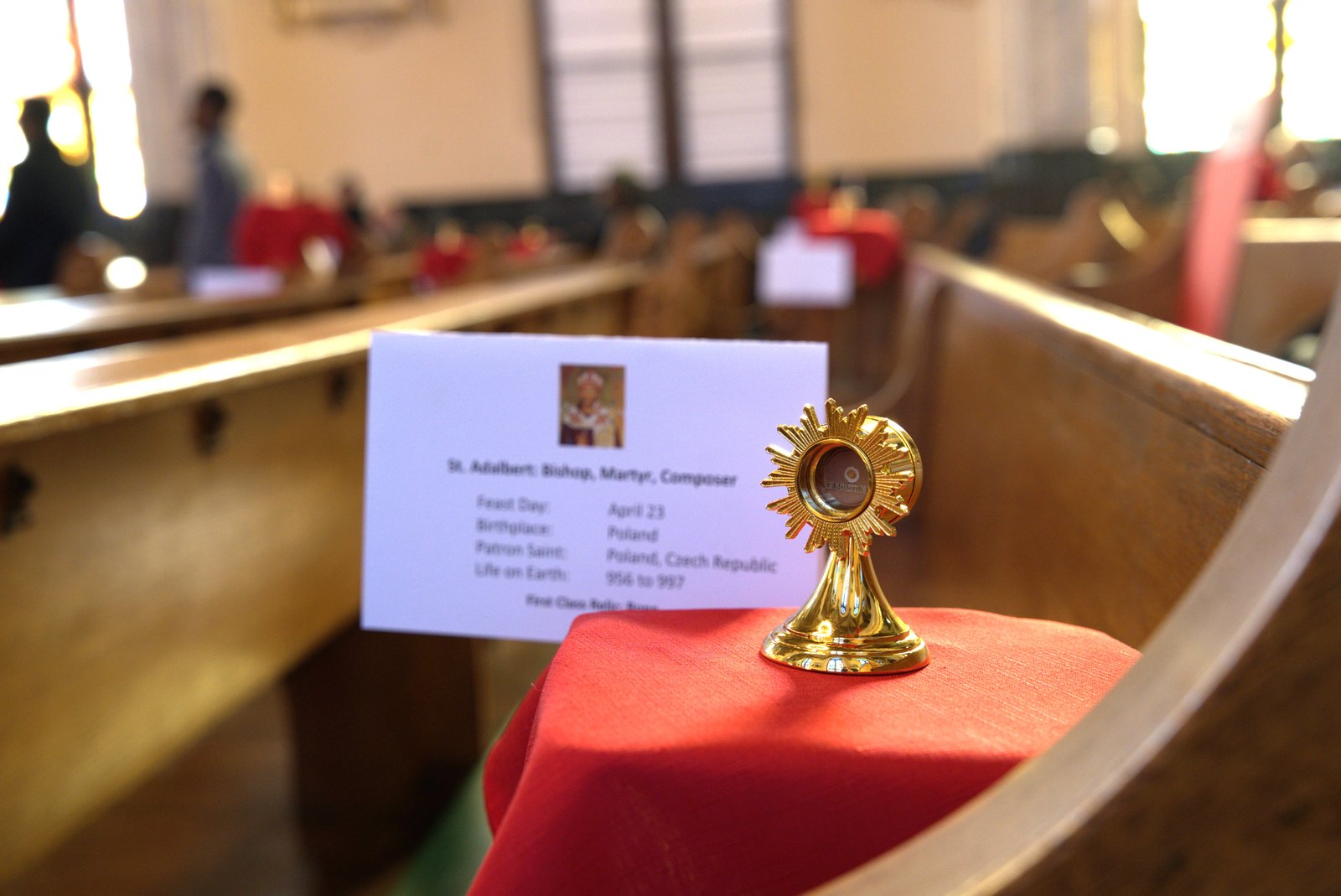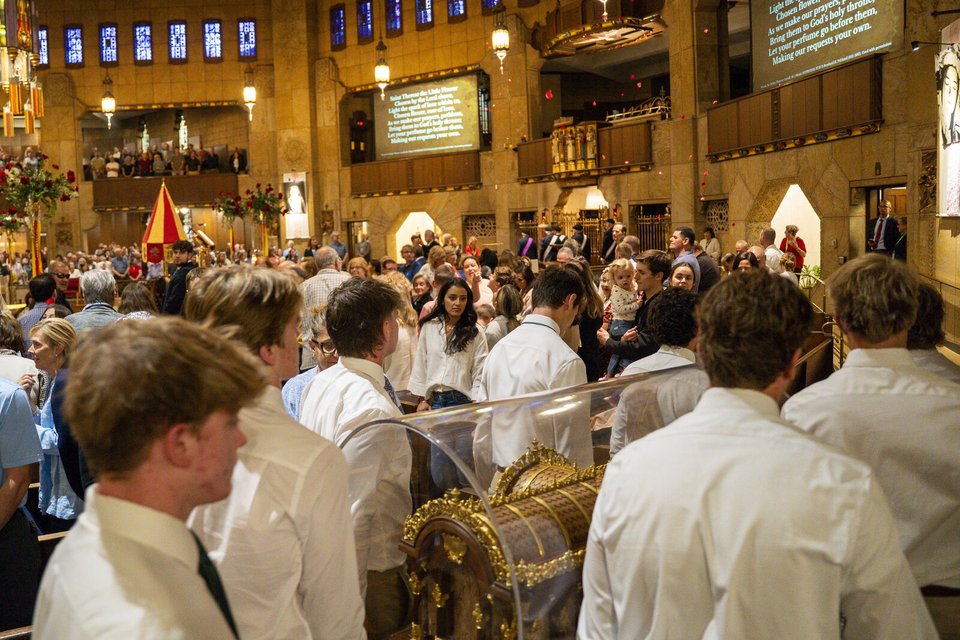Church's 125 relics, including True Cross and Mary's Veil, are displayed monthly in rotation after being discovered in 2012
DETROIT — Saints shared the pews with the faithful during Mass at Sweetest Heart of Mary Church in Detroit on Nov. 3.
Granted, the saints are always present every time the Holy Sacrifice of the Mass is celebrated. But the Church Triumphant had a physical presence at Mass en masse, as 81 relics were on display for veneration throughout the pews of the church.
Sweetest Heart of Mary hosted its fourth "A Day with the Saints" first-class relics exposition following Mass, allowing the faithful to view up close the parish's extensive treasure of relics, to pray with the relics, touch them and come into close contact with earthly remains of the saints who reside in Paradise.
Sweetest Heart of Mary, one of two churches that make up Mother of Divine Mercy Parish, has 125 relics in its possession, including relics from the lives of Jesus Christ and the Blessed Virgin Mary, such as the True Cross, the Holy Manger, the Flagellation Pillar and the Blessed Virgin Mary's Veil.
After Mass, people wandered up and down the aisles of the church, taking time to read about the saints they were venerating, praying and pressing holy cards and rosaries up against the reliquaries.

The day was a chance for the parish to display the true treasures of the Church, said Patricia Stephanoff, caretaker of the relics at Sweetest Heart of Mary.
"People come and venerate the relics because they are a bridge for us," Stephanoff told Detroit Catholic. "We are here in the Church Militant, fighting and trying. We know when we die we are going to go somewhere; we want to go to heaven, but to get there, we have all these holy saints, and Mary, the queen of saints, that we can ask prayers (from). They are closer to God than we are, so there are a lot of miracles that do happen when relics are venerated like they are today."
The relics were displayed in the pews of the church in the order of the liturgical year, with the exceptions of the relics belonging to the Holy Family, which were located at the altar rail.
"The relics little pieces of heaven here on earth," said Fr. Greg Tokarski, a priest in solidum serving Mother of Divine Mercy Parish (which includes Sweetest Heart of Mary Church and nearby St. Josaphat Church), in his homily. "They are the links between us here on earth, and the saints in heaven who we remembered on All Saints Day and to help us commemorate the dead we remembered on All Souls Day."

On most days the relics are located in a reliquary cabinet in the back of the church and are rotated in and out on a monthly basis, with each saint's relic being on display for veneration when it's the month of their feast day.
The reliquary cabinet was built in 2012 by Sweetest Heart of Mary parishioner Zachery Cebulski for his Eagle Scout project. Zachery's father, Rodger, was attending Mass and told Detroit Catholic about the history of the cabinet and the parish's commitment to giving people a chance to venerate its bountiful supply of relics.
"Fr. Paul Czarnota was the pastor at the time, and he initially wanted Zachery to build a Stations of the Cross in the courtyard," Cebulski said. "But when Father was on the third floor of the rectory, cleaning out a closet, he found these King Edward Cigar boxes on a shelf, and inside were first-class relics. He then switched gears about what Zachery would do for his Eagle Scout project."
Cebulski takes great pride that it was his son's craftsmanship that got the relics out of cigar boxes and into a more appropriate place where people throughout the year have access to the saints.

"Spiritually, this is such a big help for people," Cebulski said. "As a father, to see people going to the reliquary that he built at every Mass, it's extremely powerful. Professionally, he's a sign-language interpreter now, so he is helping communicate. Just like how this display helps people communicate with the saints."
The parish got to work getting the proper identification papers for each relic. During the relic tour at the church, the relics are displayed next to a card describing the saint, their feast day and patronage, and what particular part of their body the first-class relic comes from.
"When you display relics in any way, it is important that you have the official documents that authenticate that, 'Yes, this is the relic, this is the saint,'" Stephanoff said. "It was quite the project to match up the documents and present them in a respectful way. So we use the cabinet Zachary made. There are 12 compartments in the cabinet, so we display the relics on a monthly basis, since we can't fit over 100 relics in there."
Relics of the Holy Family that were placed on the altar rail were the most popular stops in the self-guided tour, with many of the faithful taking the time to venerate each relic, often with great emotion on their faces.
"When you come here, you see people cry because they are praying so sincerely for whatever it is they would like to happen for a loved one or some other cause," Stephanoff said. "We think it's important for people to hold the relics, kiss the relics, because the relics are for everyone for public veneration, and we're glad we are able to do this, not just for our parishioners, but visitors throughout the archdiocese."

Stephanoff makes it a point to go to the relic of a particular saint when she has a particular prayer request for a friend, such as to St. Peregrine, the patron saint of cancer patients, or St. Dymphna, the patron saint of those dealing with mental illness, paralytics and epileptics. It is when she is in the presence of the relics she gets a greater sense of the universal nature of the Church.
Upon being asked about her favorite relic present in the church, Stephanoff pointed to the St. Michael the Archangel Stones, taken from a grotto that has been built in a cave where St. Michael the Archangel appeared to an Italian bishop in 493.
Each of the relics tells a story about a saint, which in turn tells the story of the Church. It's a rich tradition Stephanoff wishes more Catholics would come to appreciate: that the saints are among us.
"You know, sometimes people look at these relics as kind of creepy, because most first-class relics are body parts of these holy men and women," Stephanoff said. "But it's very biblical. If anyone researched relics, they would see Old Testament and New Testament examples of how relics, parts of saints' bodies, have equated to miracles for people. They are wonderful treasures for the Church."
Copy Permalink
Saints












